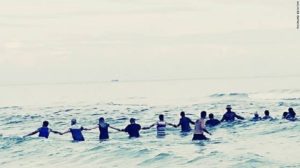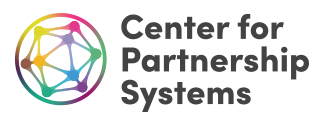July 16, 2017
By Valerie Young
Did you hear about the drowning family pulled by a rip tide off the Florida coast who were saved by beachgoers forming a human chain? It?s a true story of partnership in action.
As reported by The Washington Post, the rescue took place on a recent Saturday evening off Panama City Beach when no lifeguard was on duty. Ten people, including one family of six, had been caught in a treacherous current and were struggling to keep their heads above water about 100 yards off shore. Observers had no life-saving equipment and police were waiting for the arrival of a rescue boat, but the swimmers were quickly becoming exhausted.
Someone called out, ?Form a human chain!? Quickly as many as 80 volunteers jumped in, linking arms, and closed the gap  to the struggling swimmers. The two boys, ages 11 and 8, were passed back, link by link, all the way to shore. Within an hour, the 8 remaining swimmers were helped back, including the boys? 67 year old grandmother, who suffered a massive heart attack in the water. All survived.
to the struggling swimmers. The two boys, ages 11 and 8, were passed back, link by link, all the way to shore. Within an hour, the 8 remaining swimmers were helped back, including the boys? 67 year old grandmother, who suffered a massive heart attack in the water. All survived.
Why would so many strangers risk their own lives to save 10 drowning people? What does this event tell us about our capacity to further the well-being of others? And how does this prove that partnership is a system capable of yielding valuable results?
In a partnership system, power is used to empower everyone. All people are valued. There is no top-down ranking and hierarchy of status where everyone knows his or her place. Both genders share equal regard, as do stereotypical gender attributes, such as caring, compassion, tolerance, strength, leadership, and courage. These characteristics are not assigned rigidly to one or the other gender, and one gender is not punished for behaving in a way assigned to the other. Women?s bravery is celebrated as much as men?s caring. Partnership does not seek domination, by one gender over another, or by a race, ethnicity, religion, or tribe over others.
In contrast, a domination system uses power to control and subordinate, within a family, state, or tribe. Domination uses violence, coercion, and fear to institute and maintain top down authority. Rigid rankings assign individuals a place in the hierarchy, and deviating from expectations is discouraged, then punished. Domination systems in families put men over women and fathers over children. Domination systems in the state put men in leadership and marginalize anything feminine, relegating ?women?s issues? to a place of low status and regard. Caring, compassion, and tolerance are seen as ?unmanly? and devalued. Strength, force, and intimidation are encouraged and prized.
It was partnership that saved nearly a dozen people on that Saturday night on Panama City Beach. Every link in that human chain embodied care, compassion, strength, and courage, whatever the gender, age, and race of that link. A diverse group of people saved a different diverse group of people who needed them. That is the power of partnership.
Partnership is a system that yields valuable results
Why did 80 strangers risk their own lives to save 10 drowning people? Because at any given moment, any of us could be swept away by a rip tide and need saving. Even beyond this, because we humans have a great capacity to care for others, be they strangers or kin, regardless of their gender, race, age, or ethnicity.
And how does this prove that partnership is a system that yields valuable results? No one person, even the strongest, most powerful person, could have alone rescued 10 exhausted and drowning people and moved them safely to shore. There was too much distance, too much water, and too many exhausted swimmers. It took 160 hands, 80 bodies, and an overwhelming and sustained commitment to save 10 lives in 60 minutes. The only way this could have happened is the way it did happen.
Partnership is a human chain that keeps our heads above water, moves us to safety, and endows each and every one of us to be both the rescued and the rescuer, which is truly what we are and can be.
 ? ?
? ?![]()


Leave a Reply